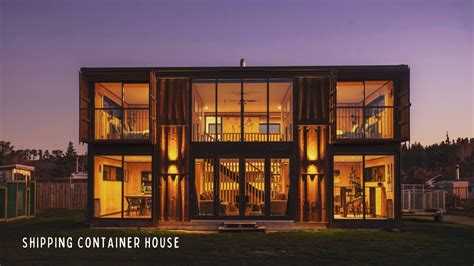
A couple’s dream of living in a custom-built shipping container home in Golden Gate Estates, Florida, has turned into a nightmare due to the persistent denial of a certificate of occupancy stemming from the absence of potable water. After investing $200,000 and two years into the project, the homeowners, identified as only Paul and Marsha, are now facing the possibility of having to abandon their unconventional dwelling, as the local authorities refuse to grant them permission to inhabit the structure without a reliable water source.
Paul and Marsha embarked on their shipping container home project with the vision of creating a unique and sustainable living space. They purchased land in Golden Gate Estates, a sprawling rural community in Collier County known for its large lots and relaxed building regulations, and began transforming several shipping containers into a modern, eco-friendly residence. The couple meticulously planned and executed the construction, incorporating features such as insulation, windows, doors, and interior finishes to make the containers livable. They believed they were creating a comfortable and stylish home that would also be environmentally responsible. However, their efforts have been stymied by a bureaucratic impasse over the provision of potable water.
The core of the problem lies in the regulations governing water supply in Golden Gate Estates. While many residents in the area rely on wells for their water needs, Collier County officials have raised concerns about the safety and reliability of the couple’s proposed water source. Paul and Marsha initially intended to use a combination of rainwater harvesting and a well to meet their water requirements. Rainwater harvesting involves collecting rainwater from the roof of the house and storing it in tanks for later use. This method is often touted as an environmentally friendly way to conserve water and reduce reliance on municipal water supplies. However, county officials have expressed doubts about the adequacy and potability of rainwater harvesting, particularly during periods of drought or low rainfall.
The couple’s well has also been a source of contention. While they drilled a well on their property, the water quality has been deemed insufficient to meet potable water standards. Potable water is water that is safe for human consumption and use, free from harmful contaminants and pathogens. Collier County regulations require that all new homes have access to a reliable source of potable water to ensure the health and safety of residents. The county has reportedly found elevated levels of contaminants in the well water, making it unsuitable for drinking, cooking, and other household uses.
Without a certificate of occupancy, Paul and Marsha cannot legally live in their shipping container home. A certificate of occupancy is a document issued by the local government that certifies that a building is in compliance with all applicable codes and regulations and is safe for human habitation. It is a crucial step in the building process, ensuring that the structure meets minimum standards for health, safety, and welfare. Without this certificate, the homeowners cannot obtain essential services such as electricity, water, and sewer, and they risk fines or even demolition of the unapproved structure.
The situation has left Paul and Marsha in a state of limbo, unsure of what to do next. They have invested a significant amount of time, money, and effort into their dream home, only to be thwarted by bureaucratic obstacles. They have explored various options for obtaining potable water, including drilling a new well, installing a water filtration system, and connecting to a nearby water line. However, each of these options presents its own challenges and costs. Drilling a new well could be expensive and there is no guarantee that the water quality will be any better than the existing well. Installing a water filtration system could be a viable option, but it would require ongoing maintenance and monitoring to ensure that the water remains safe to drink. Connecting to a nearby water line could be the most reliable solution, but it would involve extending the water line to their property, which could be costly and time-consuming.
The plight of Paul and Marsha highlights the challenges and complexities of building unconventional homes in areas with strict building regulations. While shipping container homes have become increasingly popular as an affordable and sustainable housing option, they often face scrutiny from local authorities who may be unfamiliar with this type of construction. Building codes and regulations are often designed for traditional stick-built homes and may not adequately address the unique characteristics of shipping container homes. This can lead to delays, cost overruns, and even denial of occupancy permits.
In addition to the water issue, Paul and Marsha may have encountered other challenges related to building a shipping container home. These challenges can include obtaining the necessary permits, meeting structural requirements, ensuring proper insulation, and addressing issues related to condensation and corrosion. Shipping containers are designed to withstand harsh conditions at sea, but they may not be suitable for residential use without significant modifications.
Despite the setbacks, Paul and Marsha remain determined to find a solution to their water problem and obtain a certificate of occupancy for their shipping container home. They are working with local officials, engineers, and contractors to explore all possible options and find a way to make their dream a reality. They hope that their experience will serve as a cautionary tale for others who are considering building unconventional homes in areas with strict building regulations. They advise prospective homeowners to thoroughly research local building codes, obtain all necessary permits, and work with experienced professionals who are familiar with this type of construction.
The case of Paul and Marsha also raises broader questions about the role of local governments in regulating alternative housing options. As housing affordability becomes an increasingly pressing issue, many people are turning to unconventional housing solutions such as shipping container homes, tiny houses, and modular homes. These alternative housing options can offer a more affordable and sustainable way to live, but they often face resistance from local governments who may be wary of their impact on property values, infrastructure, and community character. Local governments need to strike a balance between protecting the health and safety of residents and fostering innovation and affordability in the housing market. They should consider updating their building codes and regulations to accommodate alternative housing options while ensuring that these homes meet minimum standards for safety and sustainability.
The shipping container home movement is gaining momentum as people seek innovative, eco-friendly, and affordable housing solutions. However, stories like Paul and Marsha’s serve as important reminders of the potential pitfalls and bureaucratic hurdles that can arise when venturing outside traditional construction norms. Thorough preparation, diligent research, and open communication with local authorities are crucial for anyone considering this path. The dream of a unique, sustainable home is attainable, but it requires navigating a complex landscape of regulations and ensuring all essential services, like potable water, are secured.
Frequently Asked Questions (FAQ)
1. Why are Paul and Marsha unable to live in their shipping container home?
Paul and Marsha are unable to live in their shipping container home because they have been denied a certificate of occupancy due to the lack of potable water on their property. Collier County officials have deemed their well water unsafe for drinking and other household uses, and their rainwater harvesting system is not considered a reliable source of potable water.
2. What is a certificate of occupancy, and why is it important?
A certificate of occupancy is a document issued by the local government that certifies that a building is in compliance with all applicable codes and regulations and is safe for human habitation. It is important because it ensures that the structure meets minimum standards for health, safety, and welfare. Without a certificate of occupancy, homeowners cannot obtain essential services such as electricity, water, and sewer, and they risk fines or even demolition of the unapproved structure.
3. What options are Paul and Marsha considering to obtain potable water?
Paul and Marsha are considering several options to obtain potable water, including drilling a new well, installing a water filtration system, and connecting to a nearby water line. However, each of these options presents its own challenges and costs. Drilling a new well could be expensive and there is no guarantee that the water quality will be any better than the existing well. Installing a water filtration system could be a viable option, but it would require ongoing maintenance and monitoring to ensure that the water remains safe to drink. Connecting to a nearby water line could be the most reliable solution, but it would involve extending the water line to their property, which could be costly and time-consuming.
4. What challenges do people often face when building shipping container homes?
People often face several challenges when building shipping container homes, including obtaining the necessary permits, meeting structural requirements, ensuring proper insulation, addressing issues related to condensation and corrosion, and complying with local building codes and regulations. Building codes and regulations are often designed for traditional stick-built homes and may not adequately address the unique characteristics of shipping container homes.
5. What advice would Paul and Marsha give to others considering building unconventional homes?
Paul and Marsha advise prospective homeowners to thoroughly research local building codes, obtain all necessary permits, and work with experienced professionals who are familiar with this type of construction. They also emphasize the importance of addressing potential challenges such as water supply, insulation, and structural integrity.
Expanded Article with In-Depth Analysis and Background Information:
The saga of Paul and Marsha’s shipping container home serves as a stark illustration of the potential pitfalls and unexpected hurdles that can arise when pursuing unconventional housing options. While the allure of sustainable, affordable, and unique living spaces continues to fuel the popularity of alternative construction methods, the reality often involves navigating a complex web of regulations, bureaucratic processes, and unforeseen technical challenges. The couple’s experience in Golden Gate Estates, Florida, underscores the critical importance of thorough preparation, diligent research, and open communication with local authorities when venturing outside the realm of traditional housing.
Shipping container homes, in particular, have gained considerable traction in recent years as a viable solution to the growing housing crisis. Their inherent structural strength, modularity, and relatively low cost make them an attractive option for those seeking to build custom homes on a budget. The repurposing of shipping containers also aligns with the principles of sustainable living, reducing waste and minimizing the environmental impact of construction. However, the transition from industrial cargo carriers to habitable dwellings is far from straightforward, requiring significant modifications and careful attention to detail.
One of the primary challenges in building a shipping container home lies in complying with local building codes and regulations. These codes are typically designed for traditional stick-built homes and may not adequately address the unique characteristics of shipping containers. Issues such as structural integrity, insulation, ventilation, and fire safety must be carefully considered and addressed to ensure that the home meets minimum safety standards. In many cases, builders may need to obtain special permits or variances to deviate from standard building practices.
The case of Paul and Marsha highlights the importance of securing a reliable source of potable water, which is a fundamental requirement for any habitable dwelling. While many rural areas rely on wells for their water supply, the quality and quantity of well water can vary significantly depending on local geological conditions. Contamination from agricultural runoff, industrial waste, or natural sources can render well water unsafe for human consumption. Rainwater harvesting, while a sustainable alternative, may not be sufficient to meet all household water needs, particularly during periods of drought or low rainfall.
Collier County’s strict regulations regarding potable water reflect a growing concern about water quality and availability in Florida. The state’s rapid population growth and agricultural industry have placed increasing demands on its water resources, leading to concerns about depletion and contamination. Local governments are under pressure to ensure that new developments have access to a safe and reliable water supply, and they may be reluctant to approve alternative water sources that do not meet stringent standards.
The denial of a certificate of occupancy can have devastating consequences for homeowners who have invested significant time, money, and effort into their projects. Without this crucial document, they are unable to legally occupy their homes, obtain essential services, or secure financing. In some cases, they may even be forced to demolish their unapproved structures. The experience can be particularly frustrating for those who have followed all the necessary procedures and believe they have met all the applicable requirements.
The plight of Paul and Marsha underscores the need for greater clarity and consistency in the regulation of alternative housing options. Local governments should work to update their building codes and regulations to accommodate innovative construction methods while ensuring that these homes meet minimum standards for safety and sustainability. They should also provide clear guidance and support to homeowners who are seeking to build unconventional dwellings, helping them navigate the complex permitting process and avoid costly mistakes.
The shipping container home movement is part of a broader trend towards alternative housing solutions that are more affordable, sustainable, and adaptable to changing lifestyles. Tiny houses, modular homes, and co-housing communities are all gaining popularity as people seek to downsize, simplify their lives, and reduce their environmental footprint. These alternative housing options can offer numerous benefits, but they also require careful planning and execution to ensure that they meet the needs and expectations of their occupants.
In the case of shipping container homes, it is essential to work with experienced professionals who are familiar with this type of construction. Architects, engineers, and contractors can provide valuable guidance on design, structural integrity, insulation, ventilation, and other critical aspects of the building process. They can also help homeowners navigate the permitting process and ensure that their homes comply with all applicable codes and regulations.
One of the key considerations in building a shipping container home is insulation. Shipping containers are made of steel, which is a highly conductive material that can transfer heat and cold very quickly. Without proper insulation, the interior of a shipping container home can become extremely hot in the summer and extremely cold in the winter. There are several different types of insulation that can be used in shipping container homes, including spray foam, rigid foam board, and fiberglass batts. The choice of insulation will depend on factors such as climate, budget, and personal preferences.
Another important consideration is ventilation. Shipping containers are airtight, which means that they can trap moisture and create a breeding ground for mold and mildew. Proper ventilation is essential to prevent condensation and maintain a healthy indoor environment. Ventilation can be achieved through the use of windows, doors, and mechanical ventilation systems.
Structural integrity is also a critical factor in building a shipping container home. Shipping containers are designed to withstand heavy loads when stacked on top of each other, but they may not be as strong when used as individual structures. It is important to consult with a structural engineer to ensure that the home is structurally sound and can withstand local wind and seismic conditions.
Finally, it is essential to address the issue of corrosion. Shipping containers are made of steel, which is susceptible to rust and corrosion. To prevent corrosion, it is important to properly prepare the surface of the containers and apply a protective coating. Regular maintenance and inspection are also necessary to identify and address any signs of corrosion.
The case of Paul and Marsha serves as a cautionary tale, but it should not discourage others from pursuing their dreams of building unconventional homes. With careful planning, diligent research, and the help of experienced professionals, it is possible to create a unique and sustainable living space that meets all applicable codes and regulations. The key is to be prepared for the challenges and to work collaboratively with local authorities to find solutions that are both safe and innovative. The future of housing may well lie in embracing alternative construction methods that are more affordable, sustainable, and adaptable to the changing needs of society.









